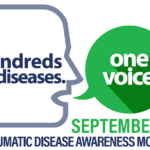As you are reading this, the Communications and Marketing Committee has already begun its work on this important campaign. This committee has partnered with public relations agency Porter Novelli and is working with other ACR committees and the ACR Research and Education Foundation to ensure that the campaign complements—not competes with—their efforts.
The ACR board of directors is committed to using public relations to reach the groups that need to hear from us. As our PR efforts continue in the coming years, the goals, objectives, and audiences targeted are likely to change. From these efforts, it is our hope that soon, when we tell someone we work in rheumatology, the face we see is a face of recognition, not confusion. With this recognition, we hope to see influential people and groups recognizing our value, understanding our issues, and making decisions that support our great profession and the patients we serve. If you have input on the campaign, contact ACR Director of Public Relations Erin Latimer at [email protected].
A Final Look Back
This is my final “President’s Perspective”; my term will come to an end in Atlanta during our Annual Scientific Meeting. It has been fascinating to be involved in ACR leadership during the ongoing debate over healthcare reform. I am writing this column on my way back from our September visit to Congress, where we had over 90 members and patients lobby on issues such as reform of the Sustainable Growth Rate formula and reinstatement of the consultation codes. I remain amazed at the willingness of our physicians and health professionals to donate their time unselfishly to serve on committees performing the ongoing work of the ACR.
Additionally, the ACR is blessed to have a tremendous full-time staff that supports the volunteers, many of who have been with the ACR for over a decade. I would be remiss if I did not acknowledge Mark Andrejeski, our executive vice president, who has been with the ACR for 24 years; this length of service is virtually unheard of in the medical society arena. The ACR is the first-class organization we have today because of his exemplary leadership and his ability to motivate and energize the staff that works with him. He is also a good friend and I hope that I can carry forward in my future roles some of the management skills I have learned from him.
When I first joined the ACR in 1978 as a fellow, all I knew of it was the journal and the annual meeting, and I expected little more from the organization. I became involved with the ACR in 1996, starting first with the ACR Research and Education Foundation and then moving to the ACR. I have witnessed tremendous growth in the activities and responsibilities of the ACR over that time. Whether it be ongoing lobbying and policy development in government affairs, enhancing our members’ ability to recertify through the American Board of Internal Medicine by offering rheumatology-specific educational courses, ensuring rheumatology input in the development of quality indicators that we will be required to fulfill, or now exploring a possible certification program for musculoskeletal ultrasound, the ACR continues to address many ongoing and new challenges. This organization exists to support its members and clearly listens to members’ concerns when developing and enhancing programs and policy. And as it was in 1978 so it remains today: our annual meeting is the premier rheumatology meeting in the world and our journals are outstanding.
